Analysis of the Summer Sea Breeze Cooling Capacity on Coastal Cities Based on Computer Fluid Dynamics
Abstract
1. Introduction
2. Data and Methods
2.1. Study Area
2.2. Data
2.2.1. Weather Station Data
2.2.2. Long-Term Multi-Point Observation Data
2.2.3. WRF Model Computes the Data
2.3. Determination of Study Day
2.3.1. Selection of Study Day
2.3.2. Study Day
3. Reproducibility Analysis of WRF Model Simulation Results
3.1. Analysis of Bias, Root Mean Squared Error (RMSE), and Correlation
3.2. Error Dynamics Analysis
4. Calculation of SBCC
5. Results and Discussion
5.1. SBCC
5.2. Trend of SBCC and Cooling Range over Time
5.3. SBCC and Distance
5.4. Inland Penetration Distance of Sea Breeze Cooling
6. Conclusions
Author Contributions
Funding
Data Availability Statement
Acknowledgments
Conflicts of Interest
Abbreviations
| WRF | Weather Research and Forecasting |
| SBCC | Sea Breeze Cooling Capacity |
Appendix A
| ID | Location | Lat. | Lon. | Distance (km) |
|---|---|---|---|---|
| 1 | Nenoshiroishi | 38.341726 | 140.796602 | 21.35 |
| 2 | Yakata | 38.312591 | 140.799167 | 19.68 |
| 3 | Teraoka | 38.340624 | 140.828391 | 18.92 |
| 4 | Nomura | 38.325285 | 140.861097 | 15.65 |
| 5 | Kita-Sendai | 38.297756 | 140.861212 | 13.91 |
| 6 | Kunimi | 38.27666667 | 140.845 | 14.02 |
| 7 | Asahigaoka | 38.297379 | 140.885703 | 12.15 |
| 8 | Tsurugaoka | 38.316229 | 140.929878 | 10.15 |
| 9 | Higashi Nibancho | 38.259458 | 140.874781 | 10.82 |
| 10 | Saiwaicho | 38.276957 | 140.897926 | 10.00 |
| 11 | Nishitaga | 38.219923 | 140.858828 | 11.63 |
| 12 | Hitokita | 38.224932 | 140.809892 | 14.75 |
| 13 | Nagamachi | 38.232263 | 140.880617 | 8.98 |
| 14 | Minamikoizumi | 38.244434 | 140.905447 | 7.61 |
| 15 | Fukurobara | 38.196458 | 140.903682 | 5.92 |
| 16 | Kabanomachi | 38.24194444 | 140.9291667 | 5.60 |
| 17 | Takasago | 38.272964 | 140.958098 | 5.27 |
| 18 | Rokugo | 38.21472222 | 140.9336111 | 3.75 |
| 19 | Higashishiromaru | 38.193381 | 140.923753 | 4.15 |
| 20 | Okada | 38.256679 | 140.978404 | 2.83 |
| 21 | Observatory | 38.26209 | 140.89692 | 9.43 |
| Time | Cooling Capacity (°C.h) | Cooling Area (km2) |
|---|---|---|
| 7:00 | 2092.99 | 30.6 |
| 8:00 | 12,489.48 | 115.26 |
| 9:00 | 28,891.49 | 222.36 |
| 10:00 | 37,989.61 | 277.44 |
| 11:00 | 33,062.05 | 261.12 |
| 12:00 | 28,331.30 | 236.64 |
| 13:00 | 29,149.13 | 236.64 |
| 14:00 | 22,974.94 | 221.34 |
| 15:00 | 17,250.13 | 180.54 |
| 16:00 | 13,565.42 | 153 |
| 17:00 | 8760.34 | 116.28 |
| 18:00 | 7150.46 | 93.84 |
| 19:00 | 4600.70 | 76.5 |
| 20:00 | 1888.38 | 32.64 |
| 21:00 | 400.04 | 21.42 |
References
- IPCC. Climate Change 2014: Synthesis Report. Contribution of Working Groups I, II and III to the Fifth Assessment Report of the Intergovernmental Panel on Climate Change; Pachauri, R.K., Meyer, L.A., Eds.; IPCC: Geneva, Switzerland, 2014; p. 151. [Google Scholar]
- Wang, S.; Zhu, J. Amplified or exaggerated changes in perceived temperature extremes under global warming. Clim. Dyn. 2020, 54, 117–127. [Google Scholar] [CrossRef]
- Woodward, A.; Smith, K.R.; Campbell-Lendrum, D.; Chadee, D.D.; Honda, Y.; Liu, Q.; Haines, A. Climate change and health: On the latest IPCC report. Lancet 2014, 383, 1185–1189. [Google Scholar] [CrossRef]
- Gu, S.; Huang, C.; Bai, L.; Chu, C.; Liu, Q. Heat-related illness in China, summer of 2013. Int. J. Biometeorol. 2016, 60, 131–137. [Google Scholar] [CrossRef] [PubMed]
- Xia, Y.; Li, Y.; Guan, D.; Tinoco, D.M.; Xia, J.; Yan, Z.; Yang, J.; Liu, Q.; Huo, H. Assessment of the economic impacts of heat waves: A case study of Nanjing, China. J. Clean. Prod. 2018, 171, 811–819. [Google Scholar] [CrossRef]
- Li, X.X. Linking residential electricity consumption and outdoor climate in a tropical city. Energy 2018, 157, 734–743. [Google Scholar] [CrossRef]
- Fouillet, A.; Rey, G.; Laurent, F.; Pavillon, G.; Bellec, S.; Guihenneuc-Jouyaux, C.; Hémon, D. Excess mortality related to the August 2003 heat wave in France. Int. Arch. Occup. Environ. Health 2006, 80, 16–24. [Google Scholar] [CrossRef]
- Papathoma-Koehle, M.; Promper, C.; Bojariu, R.; Cica, R.; Sik, A.; Perge, K.; Glade, T. A common methodology for risk assessment and mapping for south-east Europe: An application for heat wave risk in Romania. Nat. Hazards 2016, 82, 89–109. [Google Scholar] [CrossRef]
- Elizabeth Loughnan, M.; Tapper, J.N.; Phan, T.A.; McInnes, J. Can a spatial index of heat-related vulnerability predict emergency service demand in Australian capital cities? Int. J. Emerg. Serv. 2014, 3, 6–33. [Google Scholar] [CrossRef]
- Yang, L.; Niyogi, D.; Tewari, M.; Aliaga, D.; Chen, F.; Tian, F.; Ni, G. Contrasting impacts of urban forms on the future thermal environment: Example of Beijing metropolitan area. Environ. Res. Lett. 2016, 11, 034018. [Google Scholar] [CrossRef]
- Balchin, W.G.V.; Pye, N. A micro-climatological investigation of bath and the surrounding district. Q. J. R. Meteorol. Soc. 1947, 73, 297–323. [Google Scholar] [CrossRef]
- Oke, T.R. The energetic basis of the urban heat island. Q. J. R. Meteorol. Soc. 1982, 108, 1–24. [Google Scholar] [CrossRef]
- Peng, S.; Piao, S.; Ciais, P.; Friedlingstein, P.; Ottle, C.; Bréon, F.M.; Myneni, R.B. Surface urban heat island across 419 global big cities. Environ. Sci. Technol. 2012, 46, 696–703. [Google Scholar] [CrossRef]
- Stewart, I.D.; Oke, T.R. Local climate zones for urban temperature studies. Bull. Am. Meteorol. Soc. 2012, 93, 1879–1900. [Google Scholar] [CrossRef]
- Hogan, A.W.; Ferrick, M.G. Observations in nonurban heat islands. J. Appl. Meteorol. Climatol. 1998, 37, 232–236. [Google Scholar] [CrossRef]
- Kłysik, K.; Fortuniak, K. Temporal and spatial characteristics of the urban heat island of Łódź, Poland. Atmos. Environ. 1999, 33, 3885–3895. [Google Scholar] [CrossRef]
- Morris, C.J.G.; Simmonds, I. Associations between varying magnitudes of the urban heat island and the synoptic climatology in Melbourne, Australia. Int. J. Climatol. J. R. Meteorol. Soc. 2000, 20, 1931–1954. [Google Scholar] [CrossRef]
- Morris, C.J.G.; Simmonds, I.; Plummer, N. Quantification of the influences of wind and cloud on the nocturnal urban heat island of a large city. J. Appl. Meteorol. Climatol. 2001, 40, 169–182. [Google Scholar] [CrossRef]
- Unger, J.; Sümeghy, Z.; Zoboki, J. Temperature cross-section features in an urban area. Atmos. Res. 2001, 58, 117–127. [Google Scholar] [CrossRef]
- Seino, N.; Aoyagi, T.; Tsuguti, H. Numerical simulation of urban impact on precipitation in Tokyo: How does urban temperature rise affect precipitation? Urban Clim. 2018, 23, 8–35. [Google Scholar] [CrossRef]
- Guhathakurta, S.; Gober, P. The impact of the Phoenix urban heat island on residential water use. J. Am. Plan. Assoc. 2007, 73, 317–329. [Google Scholar] [CrossRef]
- Guan, H.; Soebarto, V.; Bennett, J.; Clay, R.; Andrew, R.; Guo, Y.; Bellette, K. Response of office building electricity consumption to urban weather in Adelaide, South Australia. Urban Clim. 2014, 10, 42–55. [Google Scholar] [CrossRef]
- Lapola, D.M.; Braga, D.R.; Di Giulio, G.M.; Torres, R.R.; Vasconcellos, M.P. Heat stress vulnerability and risk at the (super) local scale in six Brazilian capitals. Clim. Change 2019, 154, 477–492. [Google Scholar] [CrossRef]
- Smoyer-Tomic, K.E.; Kuhn, R.; Hudson, A. Heat wave hazards: An overview of heat wave impacts in Canada. Nat. Hazards 2003, 28, 465–486. [Google Scholar] [CrossRef]
- Sun, Z.; Yu, S.; Guo, H.; Wang, C.; Zhang, Z.; Xu, R. Assessing 40 years of spatial dynamics and patterns in megacities along the Belt and Road region using satellite imagery. Int. J. Digit. Earth 2021, 14, 71–87. [Google Scholar] [CrossRef]
- Morabito, M.; Crisci, A.; Gioli, B.; Gualtieri, G.; Toscano, P.; Di Stefano, V.; Orlandini, S.; Gensini, G.F. Urban-hazard risk analysis: Mapping of heat-related risks in the elderly in major Italian cities. PLoS ONE 2015, 10, e0127277. [Google Scholar] [CrossRef]
- Puygrenier, V.; Lohou, F.; Campistron, B.; Saïd, F.; Pigeon, G.; Bénech, B.; Serça, D. Investigation on the fine structure of sea-breeze during ESCOMPTE experiment. Atmos. Res. 2005, 74, 329–353. [Google Scholar] [CrossRef]
- Bouchlaghem, K.; Mansour, F.B.; Elouragini, S. Impact of a sea breeze event on air pollution at the Eastern Tunisian Coast. Atmos. Res. 2007, 86, 162–172. [Google Scholar] [CrossRef]
- Wu, M.; Wu, D.; Fan, Q.; Wang, B.M.; Li, H.W.; Fan, S.J. Observational studies of the meteorological characteristics associated with poor air quality over the Pearl River Delta in China. Atmos. Chem. Phys. 2013, 13, 10755–10766. [Google Scholar] [CrossRef]
- Pattiaratchi, C.; Hegge, B.; Gould, J.; Eliot, I. Impact of sea-breeze activity on nearshore and foreshore processes in southwestern Australia. Cont. Shelf Res. 1997, 17, 1539–1560. [Google Scholar] [CrossRef]
- Freitas, E.D.; Rozoff, C.M.; Cotton, W.R.; Dias, P.L.S. Interactions of an urban heat island and sea-breeze circulations during winter over the metropolitan area of São Paulo, Brazil. Bound.-Layer Meteorol. 2007, 122, 43–65. [Google Scholar] [CrossRef]
- Carter, M.; Shepherd, J.M.; Burian, S.; Jeyachandran, I. Integration of lidar data into a coupled mesoscale-land surface model: A theoretical assessment of sensitivity of urban-coastal mesoscale circulations to urban canopy parameters. J. Atmos. Ocean. Technol. 2012, 29, 328–346. [Google Scholar] [CrossRef]
- He, B.J.; Ding, L.; Prasad, D. Relationships among local-scale urban morphology, urban ventilation, urban heat island and outdoor thermal comfort under sea breeze influence. Sustain. Cities Soc. 2020, 60, 102289. [Google Scholar] [CrossRef]
- Dandou, A.; Tombrou, M.; Soulakellis, N. The influence of the city of Athens on the evolution of the sea-breeze front. Bound.-Layer Meteorol. 2009, 131, 35–51. [Google Scholar] [CrossRef]
- Shen, L.; Zhao, C.; Ma, Z.; Li, Z.; Li, J.; Wang, K. Observed decrease of summer sea-land breeze in Shanghai from 1994 to 2014 and its association with urbanization. Atmos. Res. 2019, 227, 198–209. [Google Scholar] [CrossRef]
- Khan, S.M.; Simpson, R.W. Effect of a heat island on the meteorology of a complex urban airshed. Bound.-Layer Meteorol. 2001, 100, 487–506. [Google Scholar] [CrossRef]
- Fovell, R.G. Convective initiation ahead of the sea-breeze front. Mon. Weather Rev. 2005, 133, 264–278. [Google Scholar] [CrossRef]
- Hu, T.; Wang, Y.; Wu, D. The interaction of an urban heat island with a sea breeze front during moist convection over Tianjing, China. Weather 2022, 77, 238–247. [Google Scholar] [CrossRef]
- Ameer, S.; Shah, M.A.; Khan, A.; Song, H.; Maple, C.; Islam, S.U.; Asghar, M.N. Comparative analysis of machine learning techniques for predicting air quality in smart cities. IEEE Access 2019, 7, 128325–128338. [Google Scholar] [CrossRef]
- Gedzelman, S.D.; Austin, S.; Cermak, R.; Stefano, N.; Partridge, S.; Quesenberry, S.; Robinson, D.A. Mesoscale aspects of the urban heat island around New York City. Theor. Appl. Climatol. 2003, 75, 29–42. [Google Scholar] [CrossRef]
- Lopes, A.; Lopes, S.; Matzarakis, A.; Alcoforado, M.J. The influence of the summer sea breeze on thermal comfort in Funchal (Madeira): A contribution to tourism and urban planning. Meteorol. Z. 2011, 5, 553–564. [Google Scholar] [CrossRef]
- Yang, J.; Xin, J.X.; Zhang, Y.; Xiao, X.M.; Xia, J.C. Contributions of sea-land breeze and local climate zones to daytime and nighttime heat island intensity. npj Urban Sustain. 2022, 2, 12. [Google Scholar] [CrossRef]
- Zhou, Y.; Guan, H.; Huang, C.; Fan, L.; Gharib, S.; Batelaan, O.; Simmons, C. Sea breeze cooling capacity and its influencing factors in a coastal city. Build. Environ. 2019, 166, 106408. [Google Scholar] [CrossRef]
- Guo, F.; Zhao, J.; Zhang, H.; Dong, J.; Zhu, P.; Lau, S.S.Y. Effects of urban form on sea cooling capacity under the heatwave. Sustain. Cities Soc. 2023, 88, 104271. [Google Scholar] [CrossRef]
- Guan, H.; Kumar, V.; Clay, R.; Kent, C.; Bennett, J.; Ewenz, C.; Simmons, C.T. Temporal and spatial patterns of air temperature in a coastal city with a slope base setting. J. Geophys. Res. Atmos. 2016, 121, 5336–5355. [Google Scholar] [CrossRef]
- Kim, Y.H.; Baik, J.J. Daily maximum urban heat island intensity in large cities of Korea. Theor. Appl. Climatol. 2004, 79, 151–164. [Google Scholar] [CrossRef]
- He, B.J. Potentials of meteorological characteristics and synoptic conditions to mitigate urban heat island effects. Urban Clim. 2018, 24, 26–33. [Google Scholar] [CrossRef]
- Zhou, X.; Okaze, T.; Ren, C.; Cai, M.; Ishida, Y.; Watanabe, H.; Mochida, A. Evaluation of urban heat islands using local climate zones and the influence of sea-land breeze. Sustain. Cities Soc. 2020, 55, 102060. [Google Scholar] [CrossRef]
- Yang, Y.; Guo, M.; Wang, L.; Zong, L.; Liu, D.; Zhang, W.; Guo, Y. Unevenly spatiotemporal distribution of urban excess warming in coastal Shanghai megacity, China: Roles of geophysical environment, ventilation and sea breezes. Build. Environ. 2023, 235, 110180. [Google Scholar] [CrossRef]
- Kolokotsa, D.; Psomas, A.; Karapidakis, E. Urban heat island in southern Europe: The case study of Hania, Crete. Sol. Energy 2009, 83, 1871–1883. [Google Scholar] [CrossRef]
- Papanastasiou, D.K.; Melas, D.; Bartzanas, T.; Kittas, C. Temperature, comfort and pollution levels during heat waves and the role of sea breeze. Int. J. Biometeorol. 2010, 54, 307–317. [Google Scholar] [CrossRef] [PubMed]
- Shen, L.; Sun, J.; Yuan, R. Idealized large-eddy simulation study of interaction between urban heat island and sea breeze circulations. Atmos. Res. 2018, 214, 338–347. [Google Scholar] [CrossRef]
- Varquez, A.C.G.; Nakayoshi, M.; Kanda, M. The effects of highly detailed urban roughness parameters on a sea-breeze numerical simulation. Bound.-Layer Meteorol. 2015, 154, 449–469. [Google Scholar] [CrossRef]
- Cenedese, A.; Monti, P. Interaction between an inland urban heat island and a sea-breeze flow: A laboratory study. J. Appl. Meteorol. Climatol. 2003, 42, 1569–1583. [Google Scholar] [CrossRef]
- Thompson, W.T.; Holt, T.; Pullen, J. Investigation of a sea breeze front in an urban environment. Q. J. R. Meteorol. Soc. A J. Atmos. Sci. Appl. Meteorol. Phys. Oceanogr. 2007, 133, 579–594. [Google Scholar] [CrossRef]
- Martilli, A. A two-dimensional numerical study of the impact of a city on atmospheric circulation and pollutant dispersion in a coastal environment. Bound.-Layer Meteorol. 2003, 108, 91–119. [Google Scholar] [CrossRef]
- Sato, T.; Ooka, R.; Murakami, S. The Effect of Building Morphology on Sea Breeze Penetration over the Kanto Plain-Analysis of Mean Kinetic Energy Balance of Moving Control Volume along Sea Breeze. Int. J. High-Rise Build. 2012, 1, 73–80. [Google Scholar] [CrossRef]
- Peng, Z.; Hu, F. A study of the influence of urbanization of Beijing on the boundary wind structure. Chin. J. Geophys. 2006, 49, 1608–1615. [Google Scholar] [CrossRef]
- Gilliam, R.C.; Raman, S.; Niyogi, D.D.S. Observational and numerical study on the influence of large-scale flow direction and coastline shape on sea-breeze evolution. Bound.-Layer Meteorol. 2004, 111, 275–300. [Google Scholar] [CrossRef]
- Gardes, T.; Schoetter, R.; Hidalgo, J.; Long, N.; Marquès, E.; Masson, V. Statistical prediction of the nocturnal urban heat island intensity based on urban morphology and geographical factors-An investigation based on numerical model results for a large ensemble of French cities. Sci. Total Environ. 2020, 737, 139253. [Google Scholar] [CrossRef]
- Al-Ruzouq, R.; Shanableh, A.; Khalil, M.A.; Zeiada, W.; Hamad, K.; Abu Dabous, S.; Jena, R. Spatial and temporal inversion of land surface temperature along coastal cities in Arid Regions. Remote Sens. 2022, 14, 1893. [Google Scholar] [CrossRef]
- Naor, R.; Potchter, O.; Shafir, H.; Alpert, P. An observational study of the summer Mediterranean Sea breeze front penetration into the complex topography of the Jordan Rift Valley. Theor. Appl. Climatol. 2017, 127, 275–284. [Google Scholar] [CrossRef]
- Crosman, E.T.; Horel, J.D. Sea and lake breezes: A review of numerical studies. Bound.-Layer Meteorol. 2010, 137, 1–29. [Google Scholar] [CrossRef]
- Hai, S.; Miao, Y.; Sheng, L.; Wei, L.; Chen, Q. Numerical study on the effect of urbanization and coastal change on sea breeze over Qingdao, China. Atmosphere 2018, 9, 345. [Google Scholar] [CrossRef]
- Kitao, N.; Moriyama, M.; Takebayii, H.; Tanaka, T. A study on making method of climate atlas in Osaka region. AIJ J. Technol. Des. 2012, 18, 255–258. [Google Scholar] [CrossRef]
- He, J.; Chen, D.; Gu, Y.; Jia, H.; Zhong, K.; Kang, Y. Evaluation of planetary boundary layer schemes in WRF model for simulating sea-land breeze in Shanghai, China. Atmos. Res. 2022, 278, 106337. [Google Scholar] [CrossRef]
- Castorrini, A.; Gentile, S.; Geraldi, E.; Bonfiglioli, A. Investigations on offshore wind turbine inflow modelling using numerical weather prediction coupled with local-scale computational fluid dynamics. Renew. Sustain. Energy Rev. 2023, 171, 113008. [Google Scholar] [CrossRef]
- Wong, N.H.; He, Y.; Nguyen, N.S.; Raghavan, S.V.; Martin, M.; Hii, D.J.C.; Deng, J. An integrated multiscale urban microclimate model for the urban thermal environment. Urban Clim. 2021, 35, 100730. [Google Scholar] [CrossRef]
- Zhang, H.; Gong, S.; Zhang, L.; Ni, J.; He, J.; Wang, Y.; Lu, S. Development and application of a street-level meteorology and pollutant tracking system (S-TRACK). Atmos. Chem. Phys. 2022, 22, 2221–2236. [Google Scholar] [CrossRef]
- Fujibe, F. Urban warming in Japanese cities and its relation to climate change monitoring. Int. J. Clim. 2011, 31, 162–173. [Google Scholar] [CrossRef]
- Peng, S.; Kon, Y.; Watanabe, H. Effects of sea breeze on urban areas using computation fluid dynamic—A case study of the range of cooling and humidity effects in sendai, Japan. Sustainability 2022, 14, 1074. [Google Scholar] [CrossRef]
- Powers, J.G.; Klemp, J.B.; Skamarock, W.C.; Davis, C.A.; Dudhia, J.; Gill, D.O.; Duda, M.G. The weather research and forecasting model: Overview, system efforts, and future directions. Bull. Am. Meteorol. Soc. 2017, 98, 1717–1737. [Google Scholar] [CrossRef]
- Skamarock, W.C.; Klemp, J.B.; Dudhia, J.; Gill, D.O.; Barker, D.M. A Description of the Advanced Research WRF Version 3. NCAR Tech; Note NCAR/TN-475+STR; National Center for Atmospheric Research: Boulder, CO, USA, 2008; p. 113. [Google Scholar] [CrossRef]
- Miao, Y.; Liu, S.; Chen, B.; Zhang, B.; Wang, S.; Li, S. Simulating Urban Flow and Dispersion in Beijing by Coupling a CFD Model with the WRF Model. Adv. Atmos. Sci. 2013, 30, 1663–1678. [Google Scholar] [CrossRef]
- Zheng, Y.; Miao, Y.; Liu, S.; Chen, B.; Zheng, H.; Wang, S. Simulating Flow and Dispersion by Using WRF-CFD Coupled Model in a Built-up Area of Shenyang, China. Adv. Meteorol. 2015, 2015, 528618. [Google Scholar] [CrossRef]
- Peng, S.; Watanabe, H. Analysis and mapping of sea breeze event time in coastal cities: A case study of Sendai. Atmosphere 2022, 13, 1484. [Google Scholar] [CrossRef]
- Takebayashi, H.; Tanaka, T.; Moriyama, M.; Watanabe, H.; Miyazaki, H.; Kittaka, K. Relationship between city size, coastal land use, and summer daytime air temperature rise with distance from coast. Climate 2018, 6, 84. [Google Scholar] [CrossRef]
- Sasaki, Y.; Matsuo, K.; Yokoyama, M.; Sasaki, M.; Tanaka, T.; Sadohara, S. Sea breeze effect mapping for mitigating summer urban warming: For making urban environmental climate map of Yokohama and its surrounding area. Urban Clim. 2018, 24, 529–550. [Google Scholar] [CrossRef]
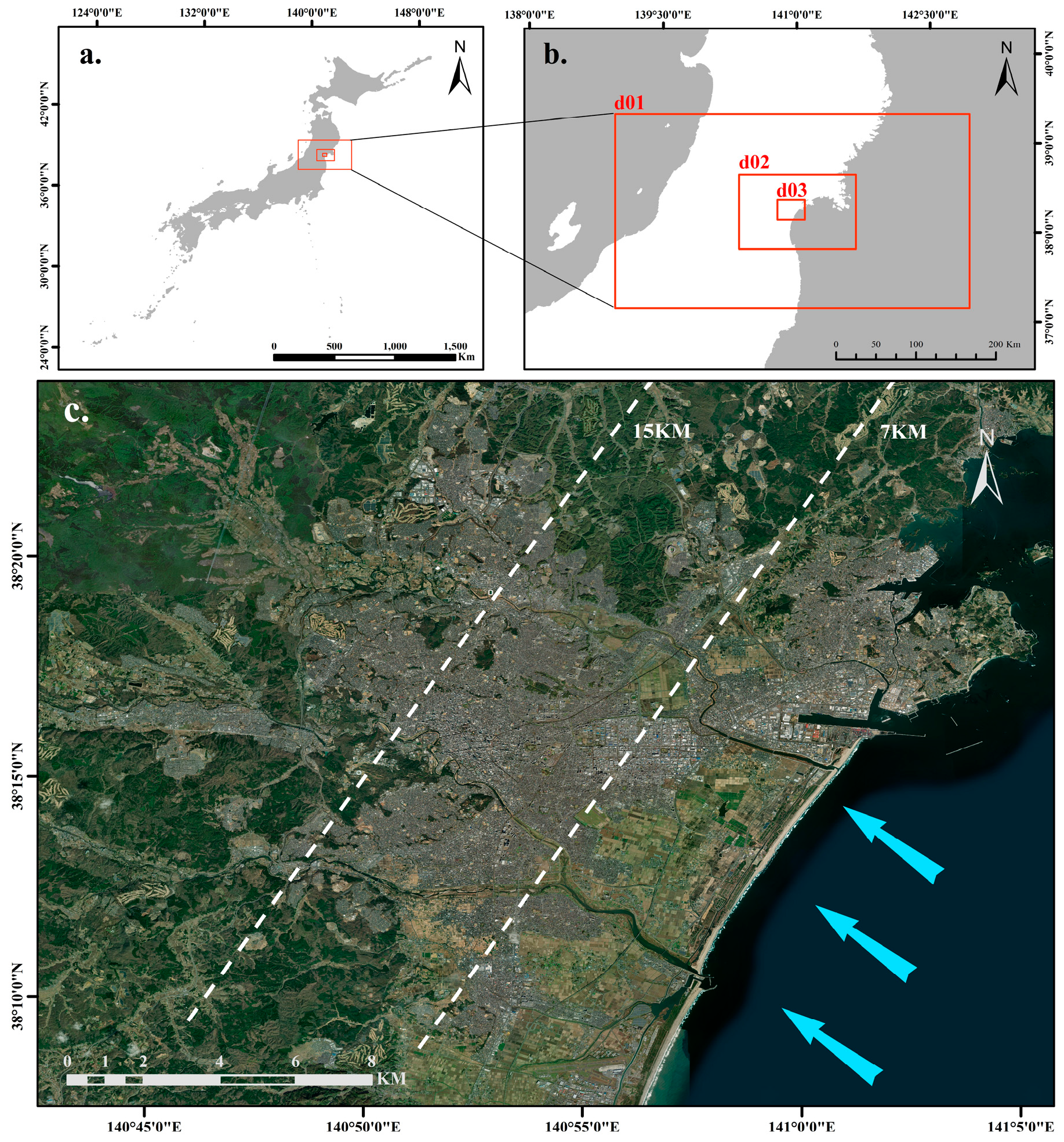
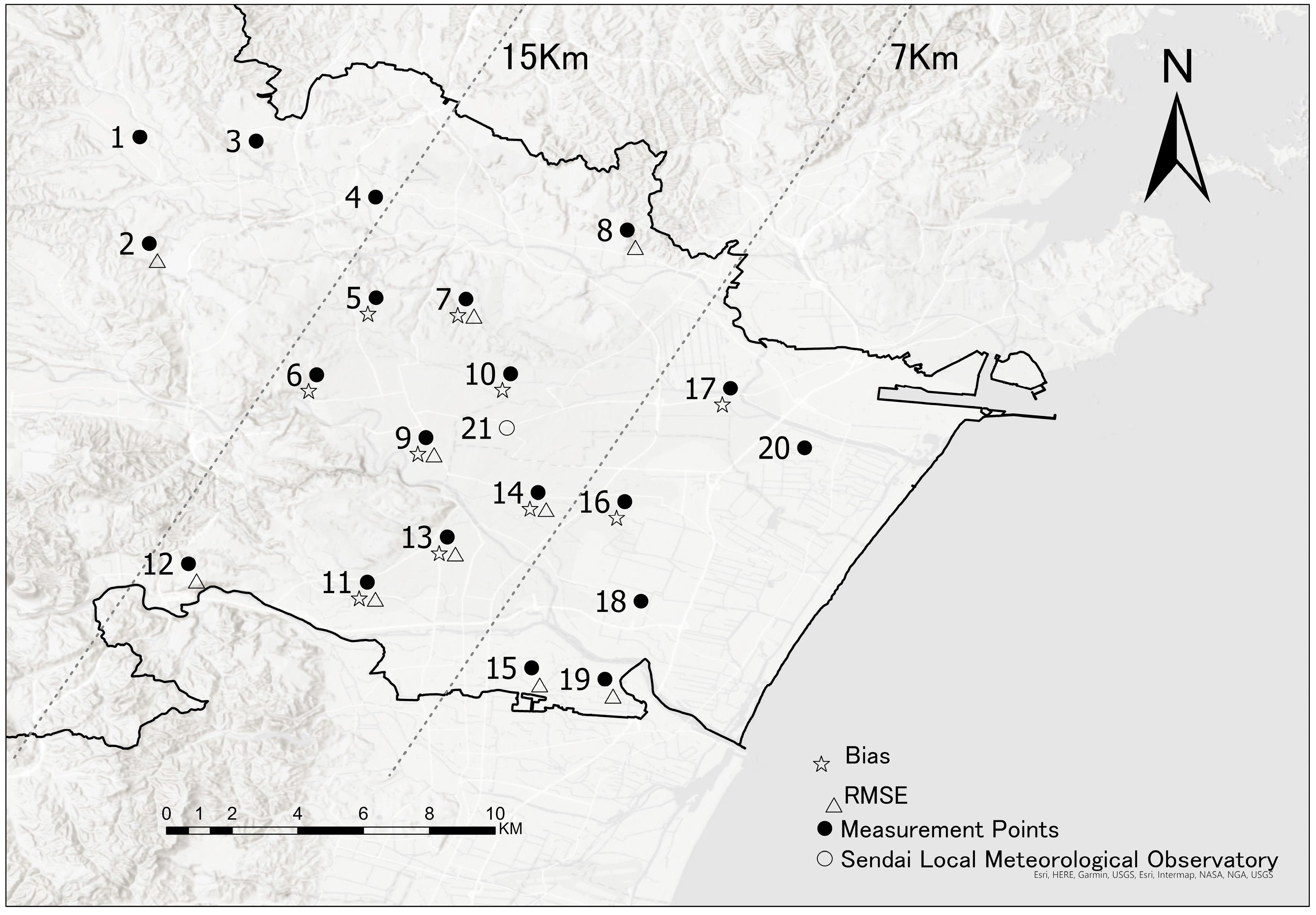
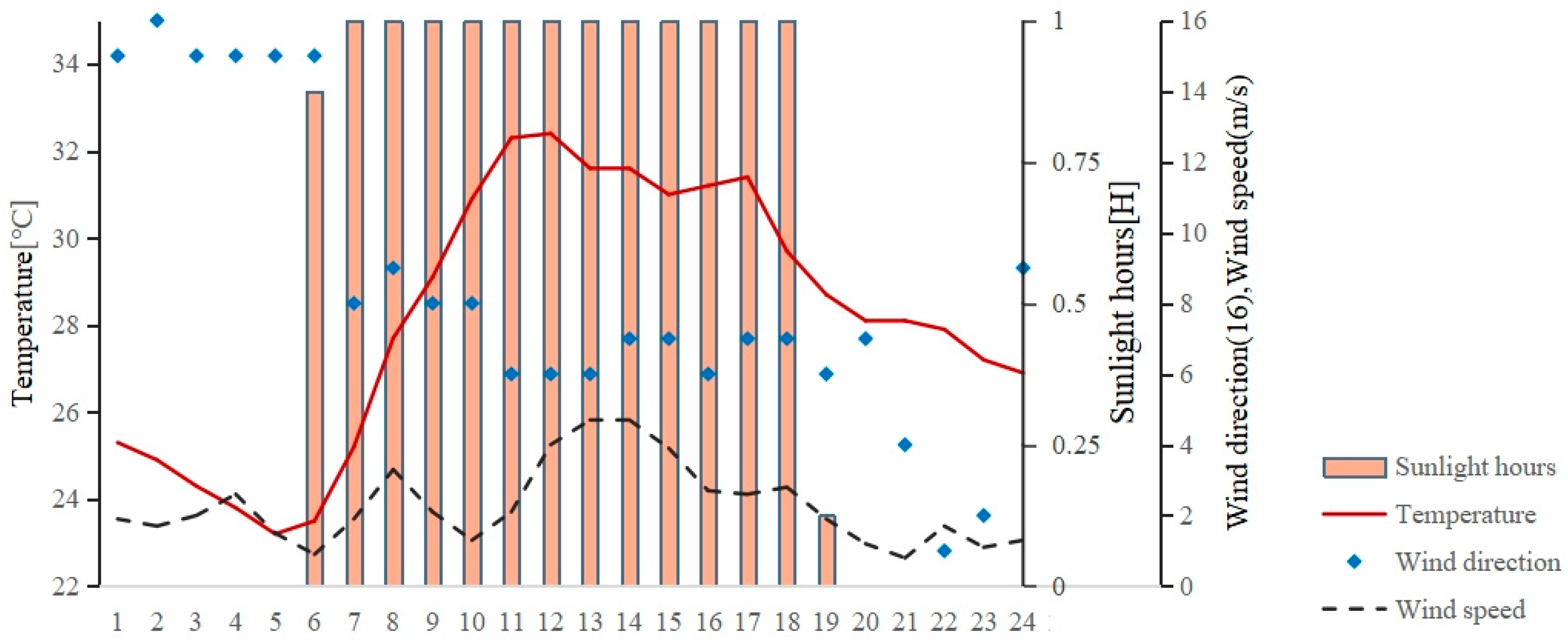
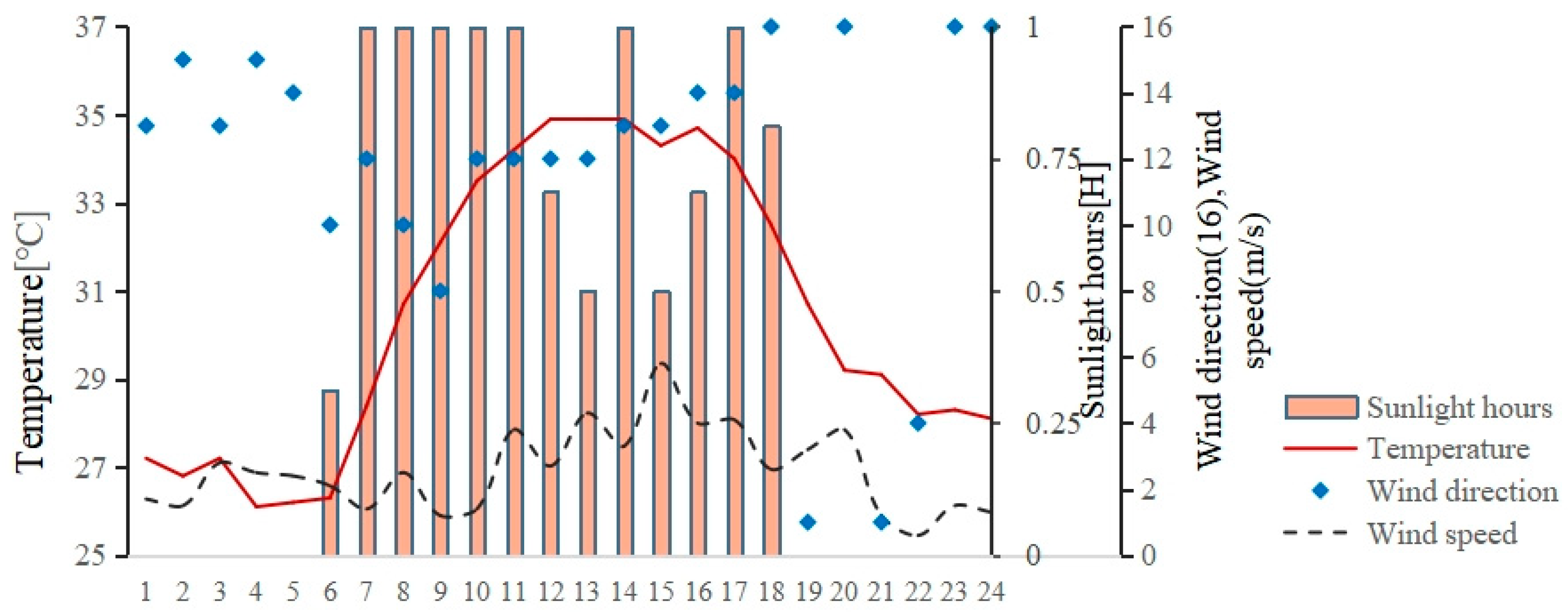
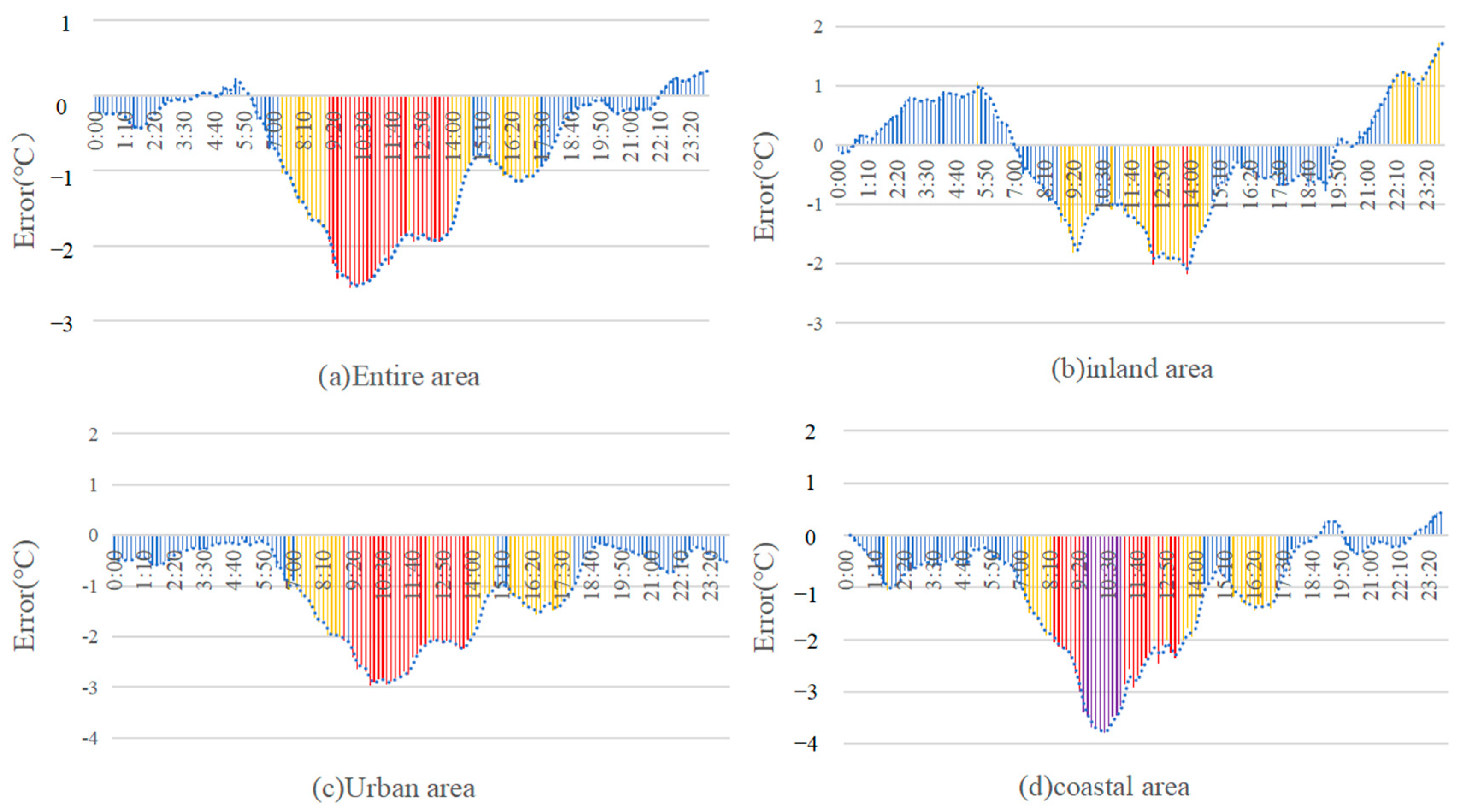
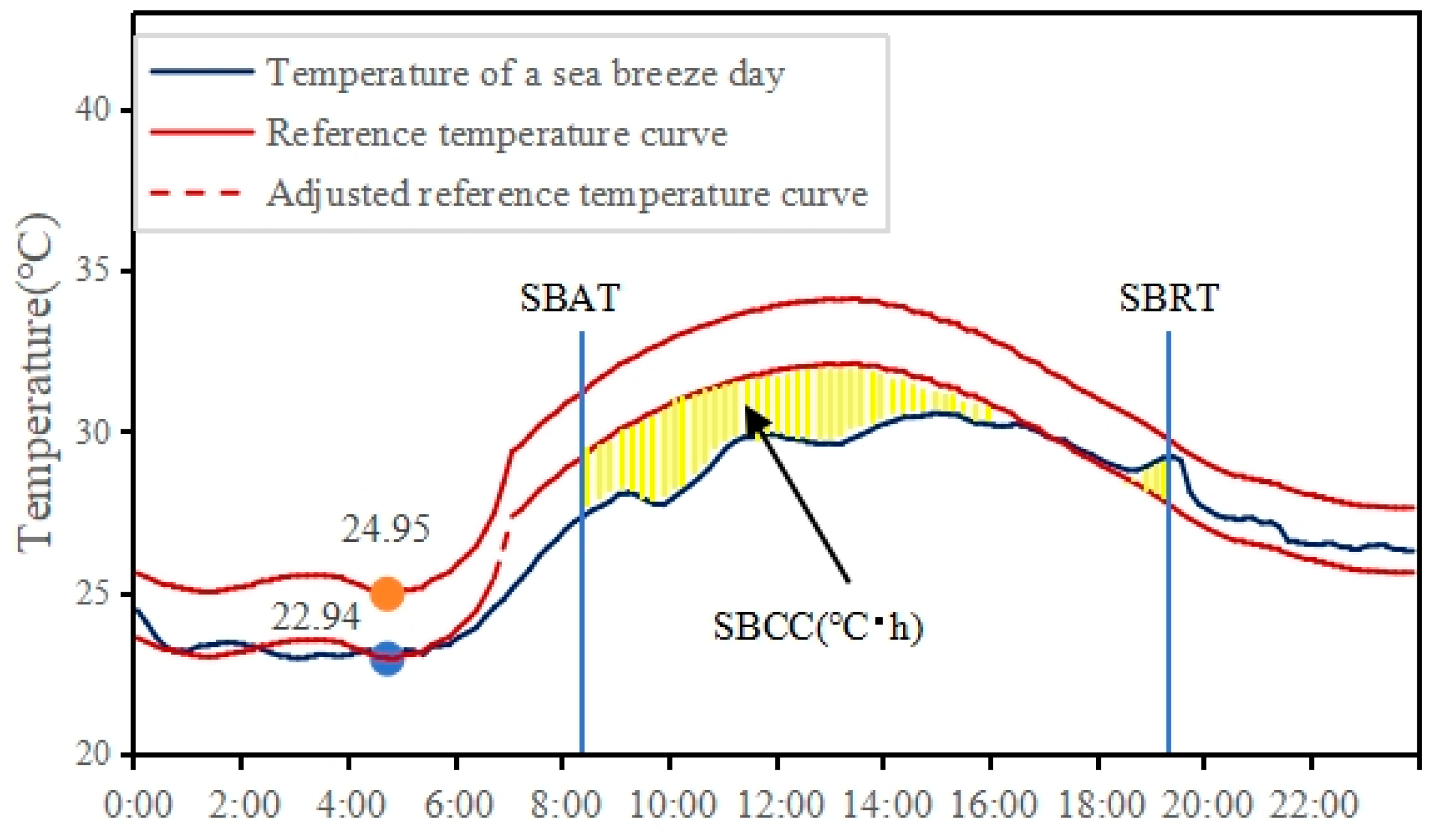
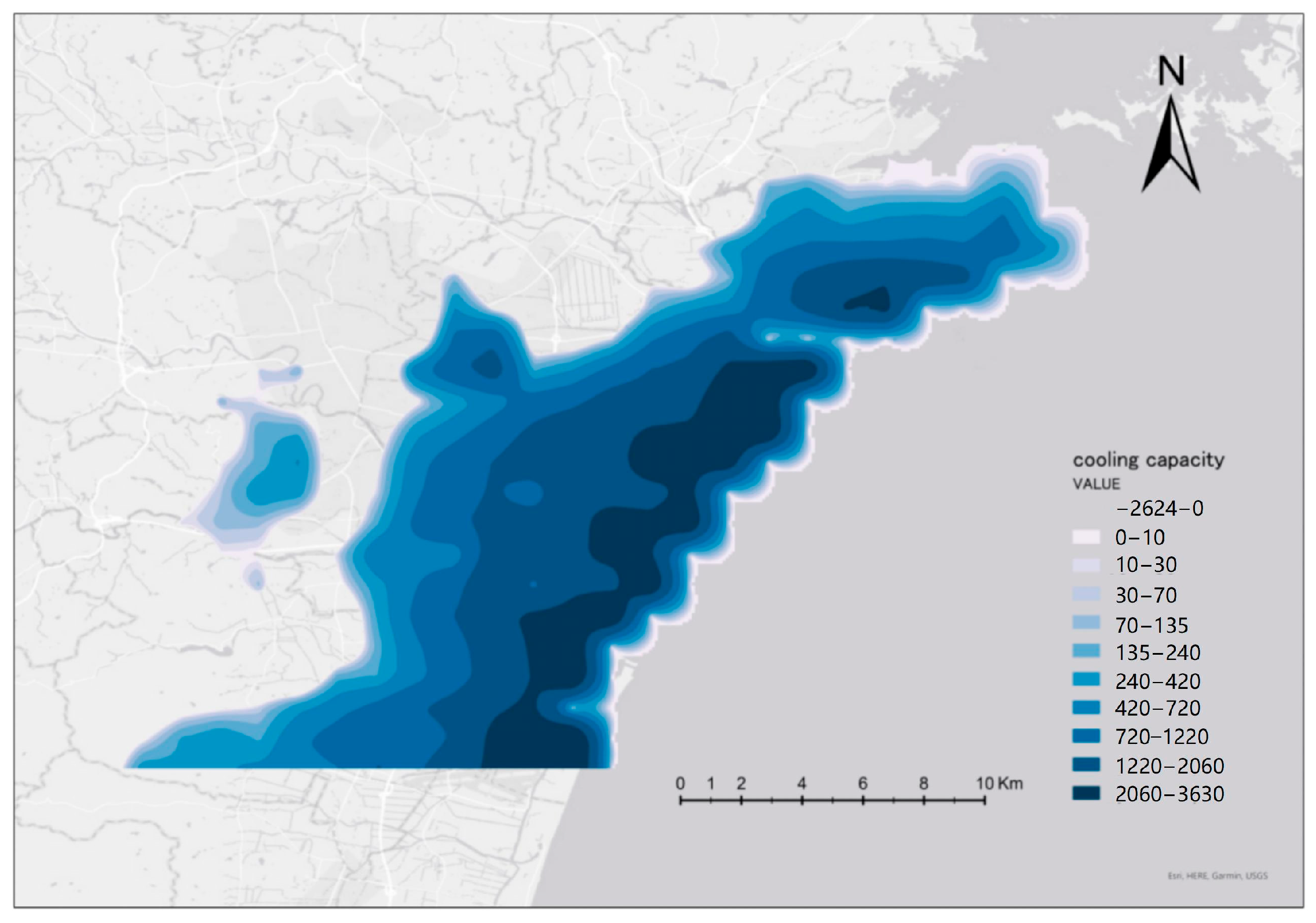
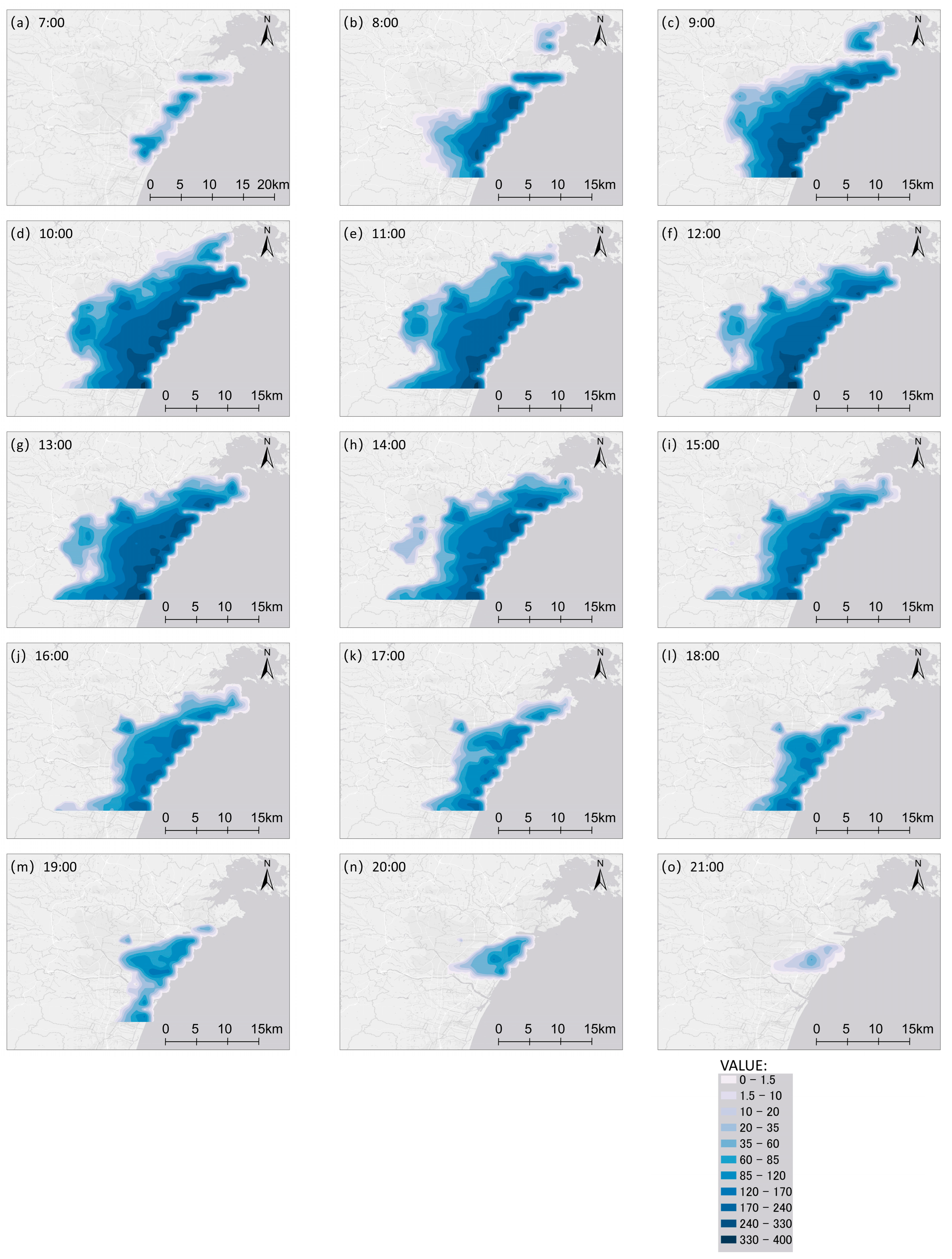
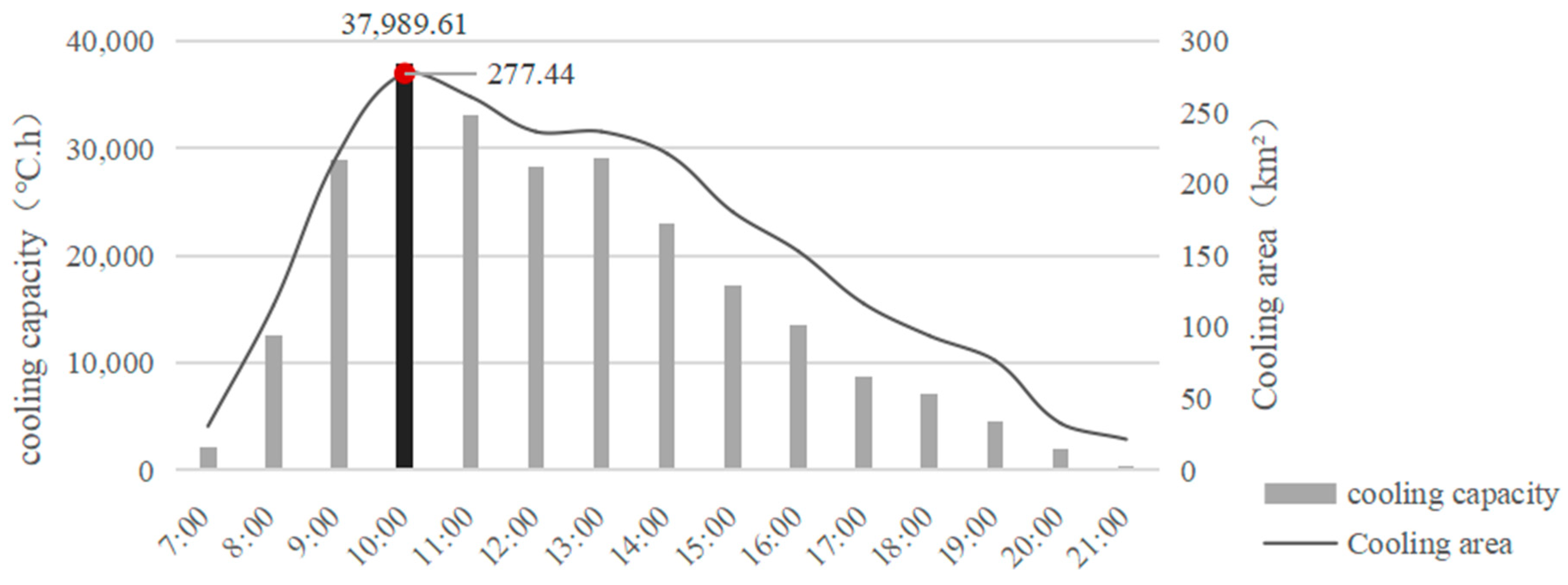

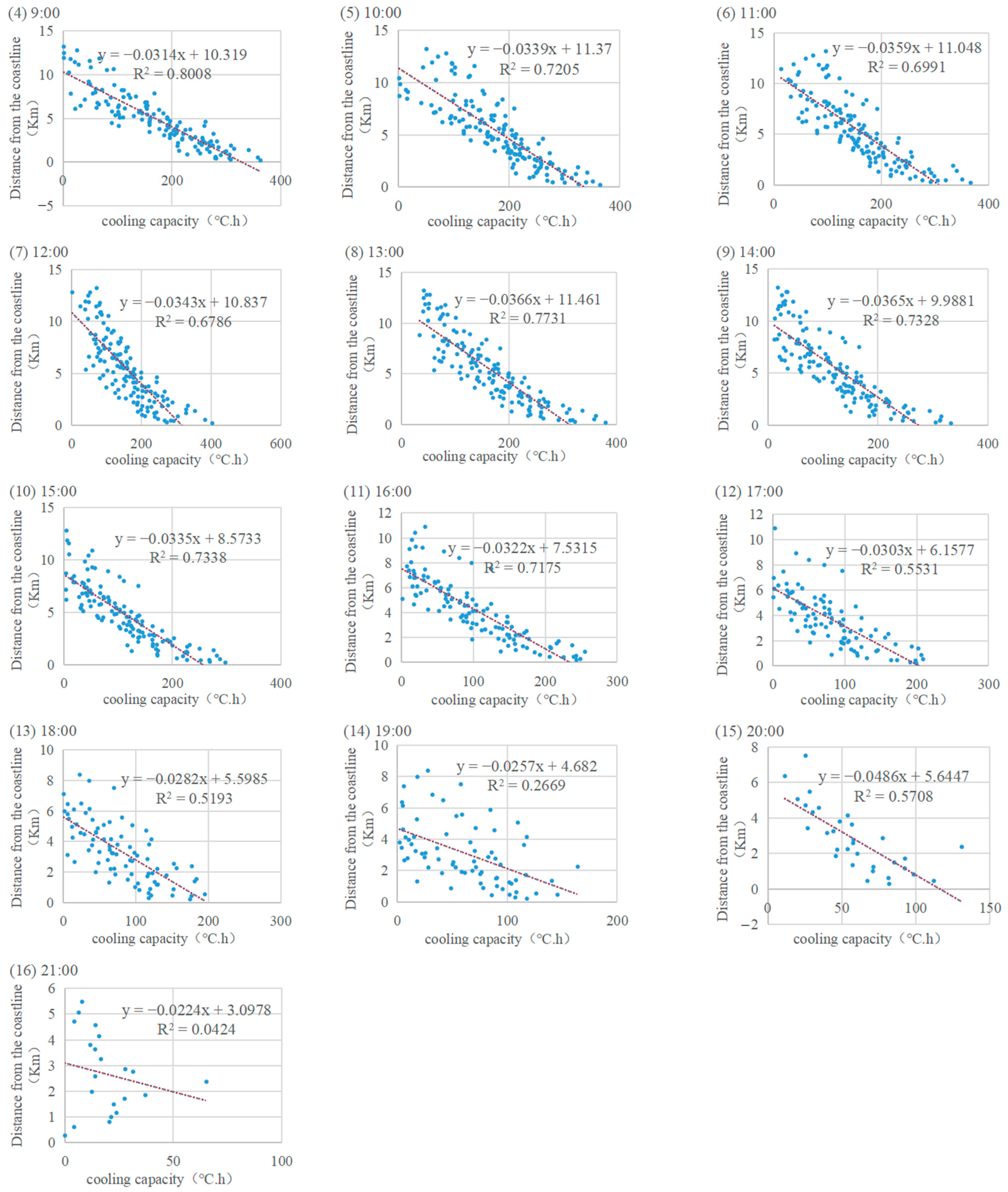
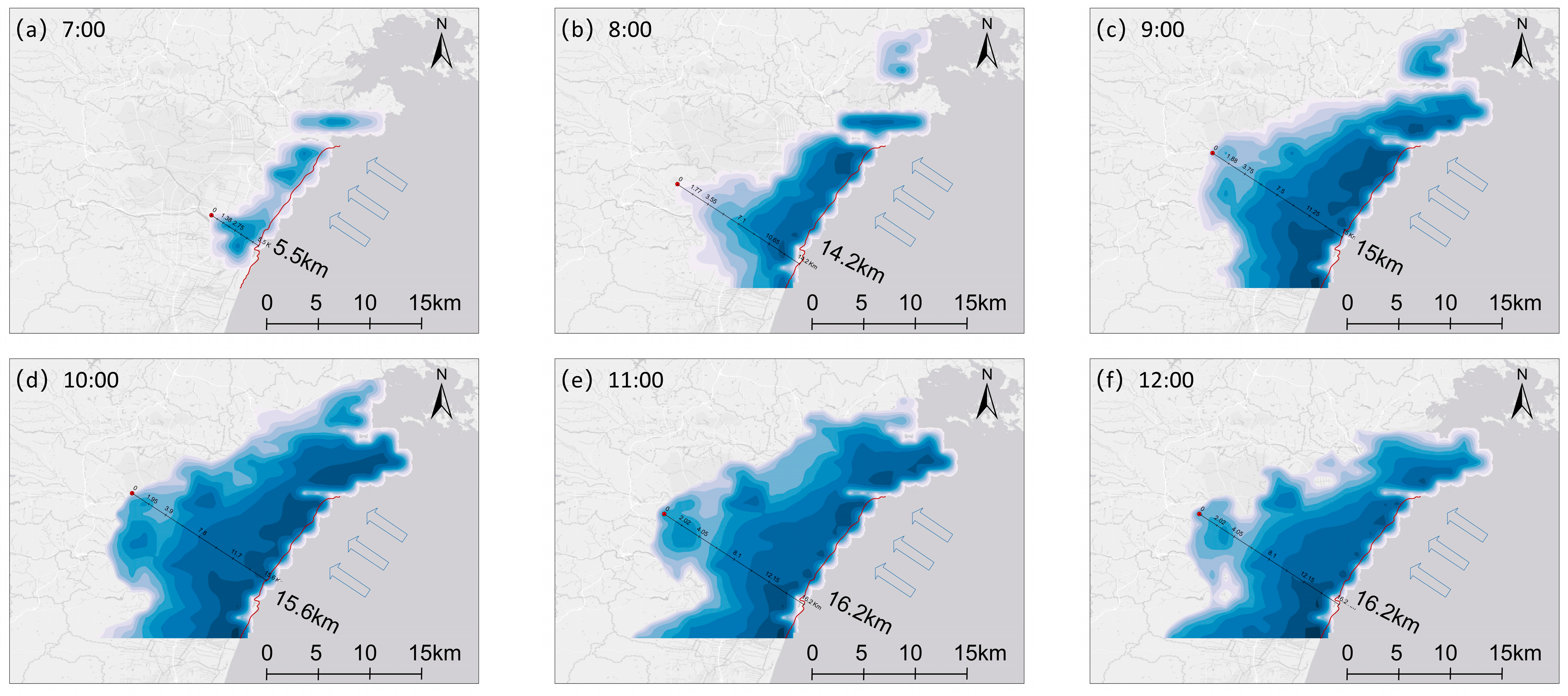
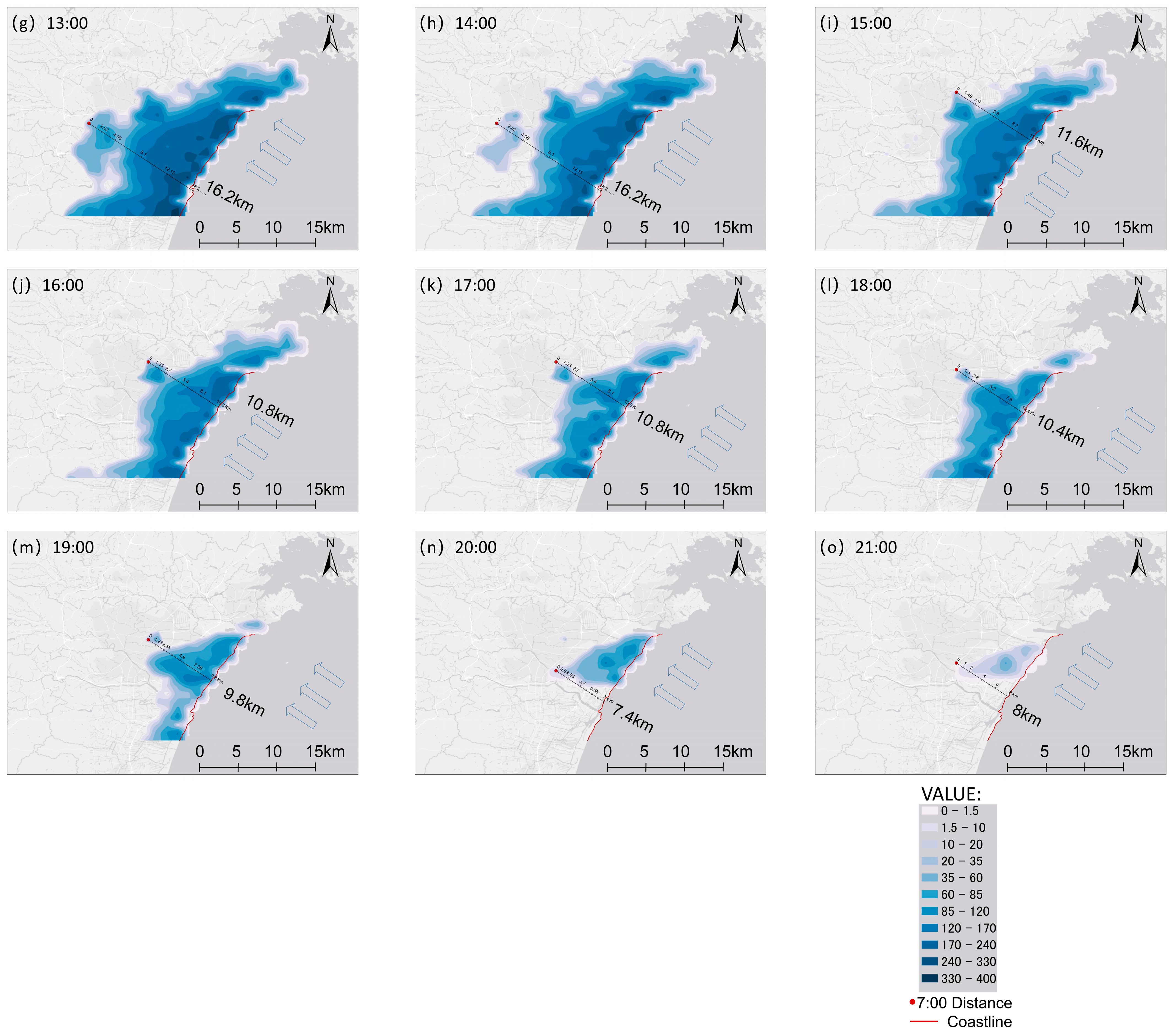
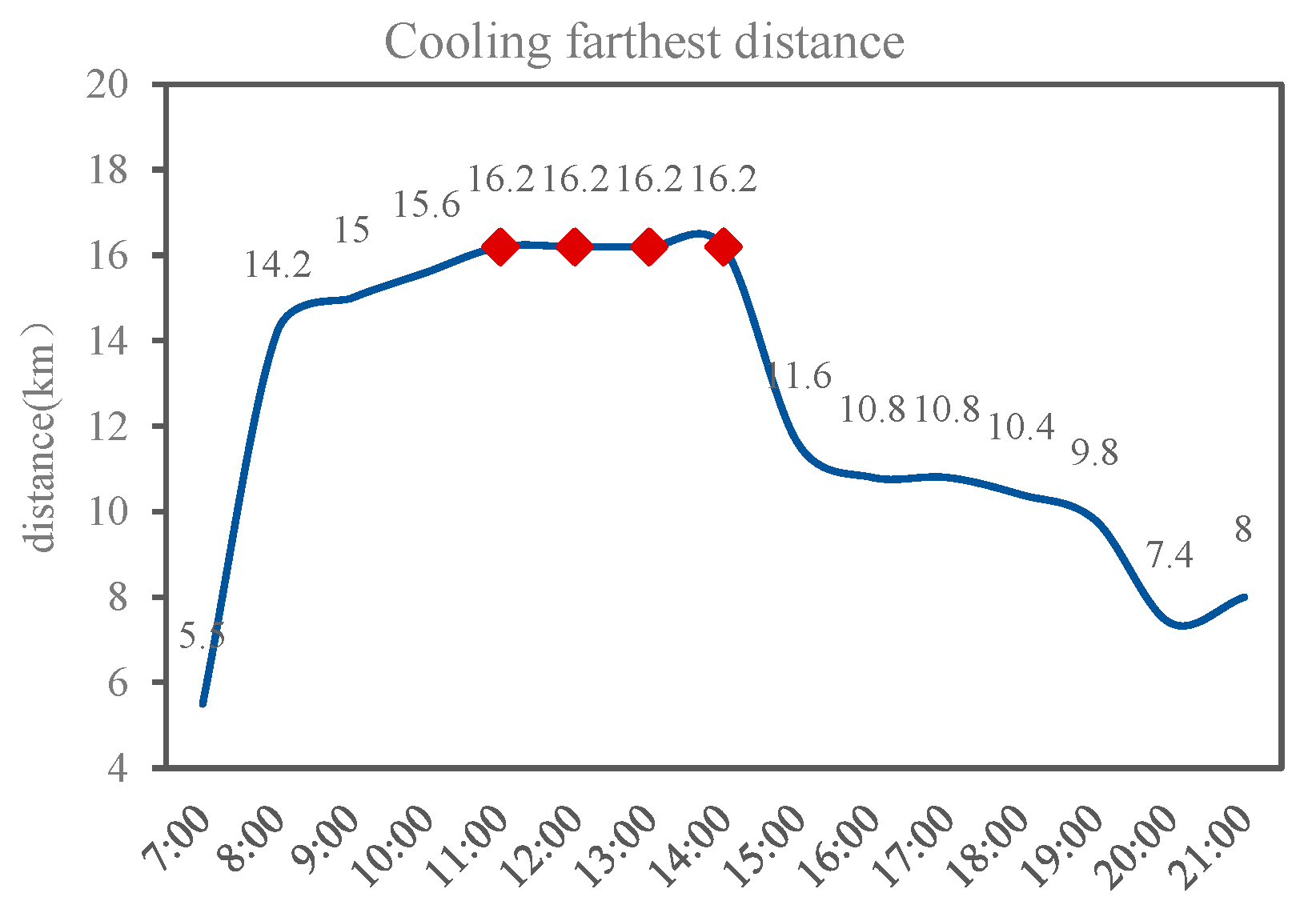
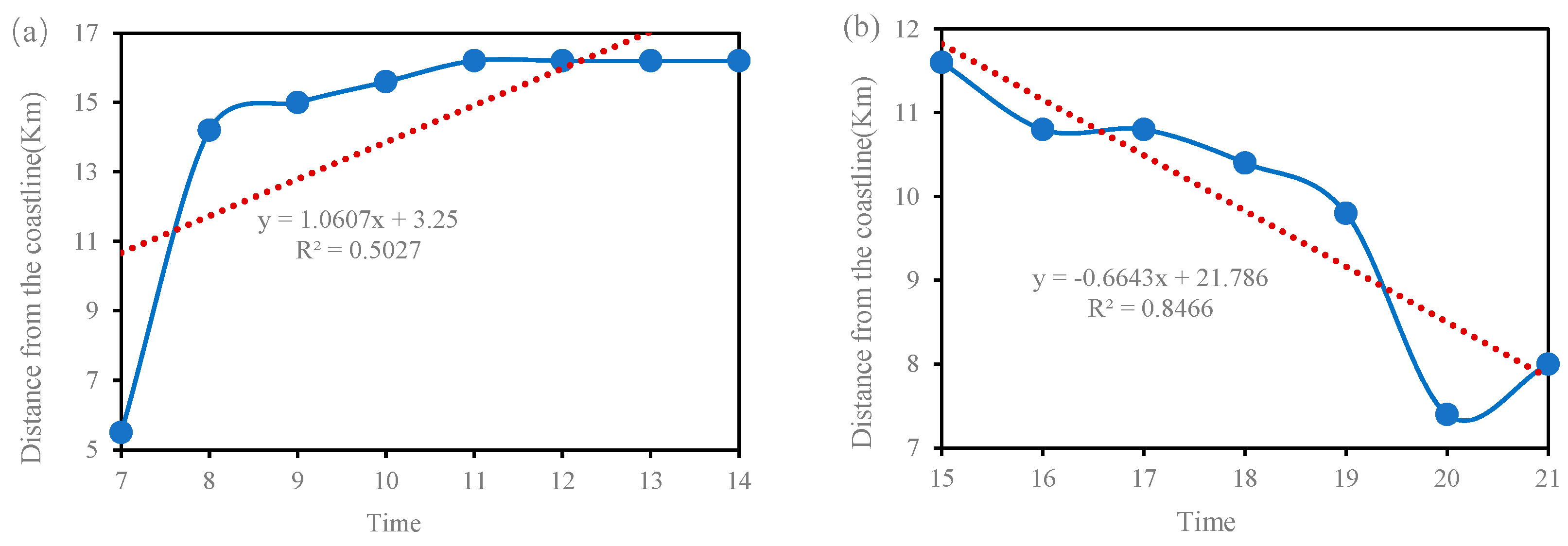
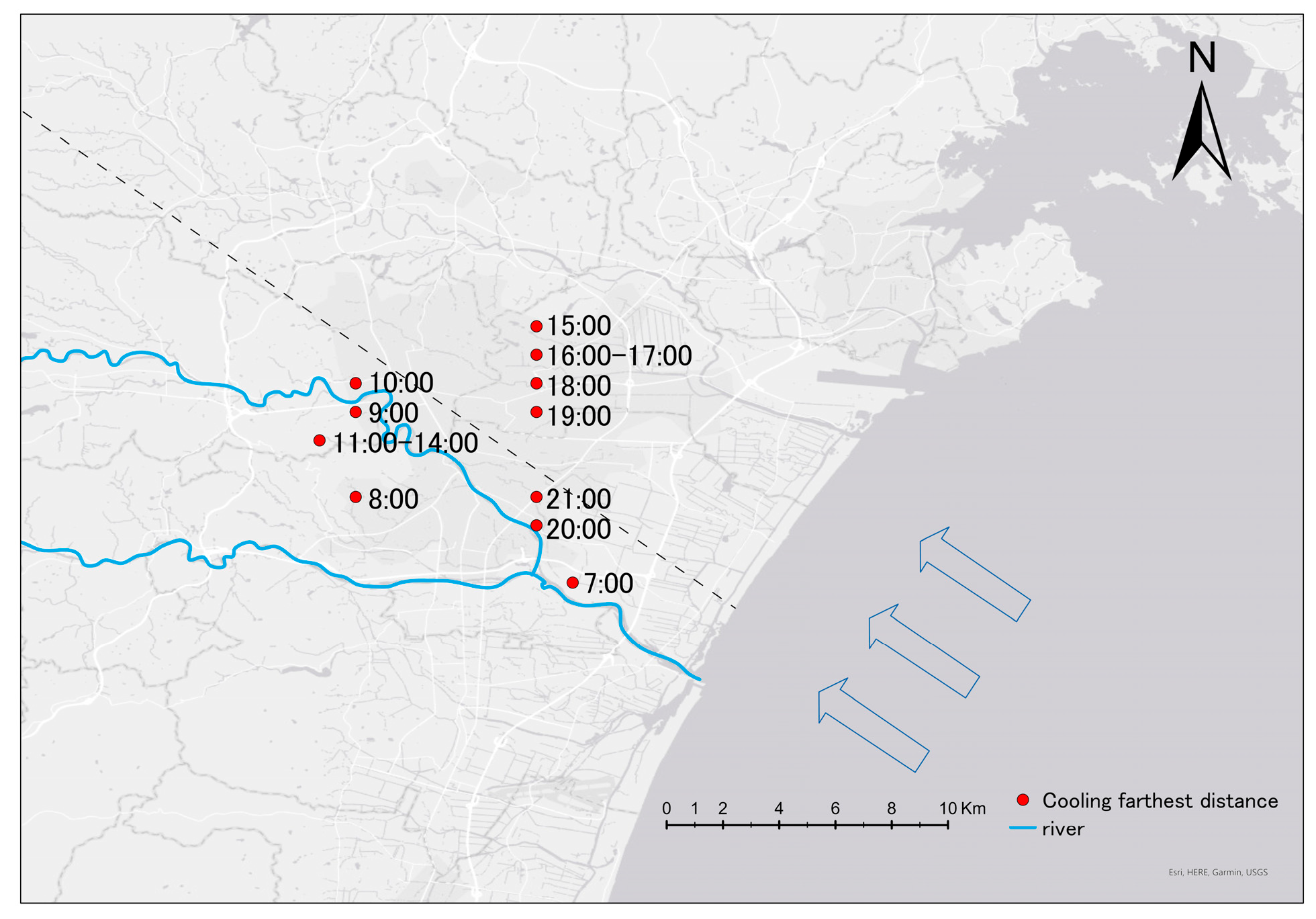
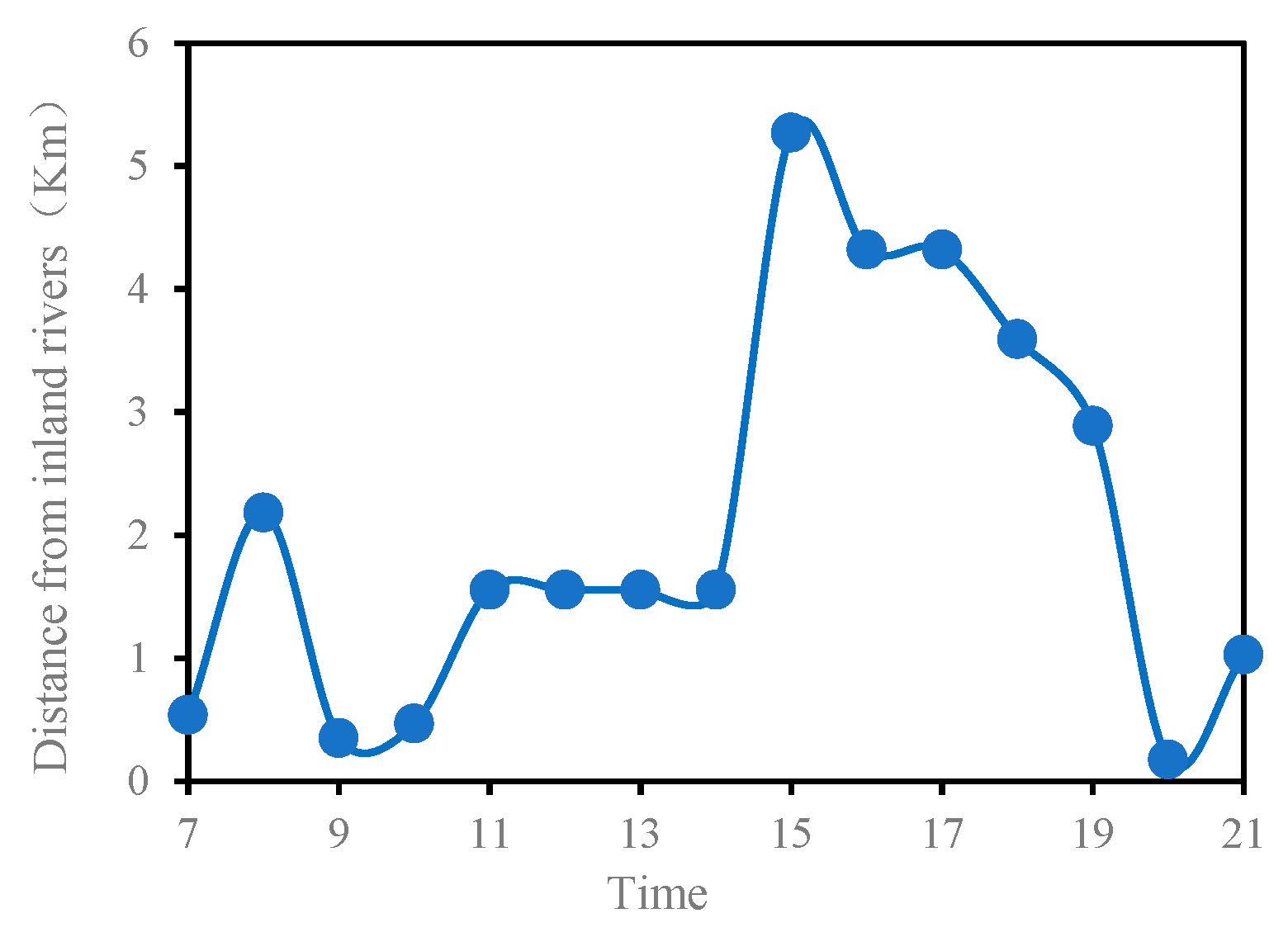
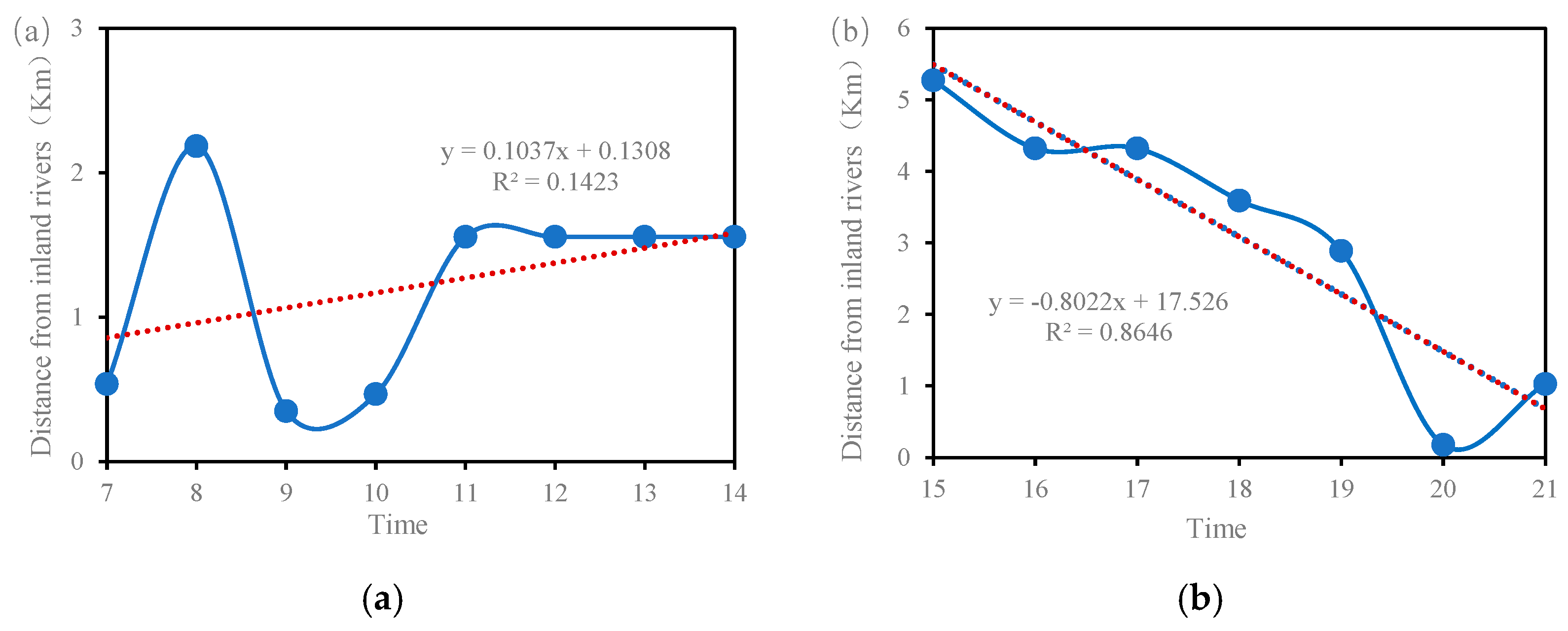
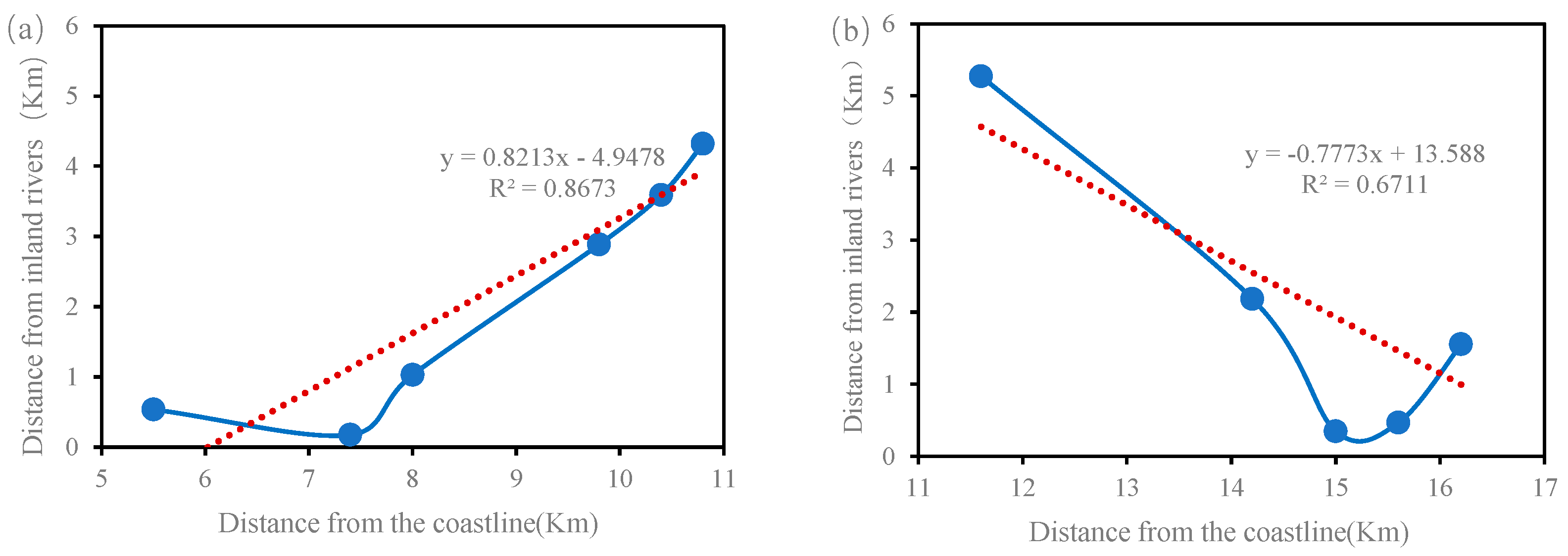
| Calculation period | 09:00 (JST) on 1 August 2016 to 09:00 (JST) on 10 August 2016 (sea breeze day) 09:00 (JST) on 5 August 2013 to 09:00 (JST) on 15 August 2013 (west breeze day) |
| Vertical grid | 30 layers (Ground Surface—50 hPa) |
| Domain 1: 9 km, dimension 37 × 28 | |
| Horizontal grid (Figure 1b) | Domain 2: 3 km, dimension 43 × 34 |
| Domain 3: 1 km, dimension 31 × 28 | |
| Meteorological data | NCEP global reanalysis data |
| Land data | Digital national land information (resolution of 1000 m) |
| Microphysics | WSM 6-class graupel scheme |
| Radiation: Longwave | Rapid radiative transfer model |
| Shortwave | Dudhia shortwave scheme |
| PBL scheme | Mellor–Yamada–Janjic TKE scheme |
| Surface scheme | Urban canopy model |
| ID | Station Name | Lon. | Lat. | FID | Lon. | Lat. | Distance (km) |
|---|---|---|---|---|---|---|---|
| 1 | Nenoshiroishi | 140.7966 | 38.3417 | 731 | 140.7933 | 38.3416 | 0.29 |
| 2 | Yakata | 140.7992 | 38.3126 | 633 | 140.8047 | 38.3144 | 0.54 |
| 3 | Teraoka | 140.8284 | 38.3406 | 734 | 140.8279 | 38.3416 | 0.12 |
| 4 | Nomura | 140.8611 | 38.3253 | 671 | 140.8627 | 38.3235 | 0.24 |
| 5 | Kita-Sendai | 140.8612 | 38.2978 | 572 | 140.8627 | 38.2963 | 0.21 |
| 6 | Kunimi | 140.8450 | 38.2767 | 504 | 140.8395 | 38.2781 | 0.51 |
| 7 | Asahigaoka | 140.8857 | 38.2974 | 574 | 140.8858 | 38.2963 | 0.12 |
| 8 | Tsurugaoka | 140.9299 | 38.3162 | 644 | 140.9320 | 38.3144 | 0.27 |
| 9 | Higashi Nibancho | 140.8748 | 38.2595 | 441 | 140.8742 | 38.2600 | 0.08 |
| 10 | Saiwaicho | 140.8979 | 38.2770 | 509 | 140.8973 | 38.2781 | 0.14 |
| 11 | Nishitaga | 140.8588 | 38.2199 | 308 | 140.8627 | 38.2237 | 0.54 |
| 12 | Hitokita | 140.8099 | 38.2249 | 303 | 140.8049 | 38.2237 | 0.46 |
| 13 | Nagamachi | 140.8806 | 38.2323 | 343 | 140.8858 | 38.2328 | 0.46 |
| 14 | Minamikoizumi | 140.9054 | 38.2444 | 378 | 140.9089 | 38.2419 | 0.41 |
| 15 | Fukurobara | 140.9037 | 38.1965 | 213 | 140.9089 | 38.1965 | 0.45 |
| 16 | Kabanomachi | 140.9292 | 38.2419 | 380 | 140.9320 | 38.2419 | 0.25 |
| 17 | Takasago | 140.9581 | 38.730 | 481 | 140.9551 | 38.2691 | 0.51 |
| 18 | Rokugo | 140.9336 | 38.2147 | 281 | 140.9319 | 38.2146 | 0.15 |
| 19 | Higashishiromaru | 140.9238 | 38.1934 | 214 | 140.9204 | 38.1965 | 0.45 |
| 20 | Okada | 140.9784 | 38.2567 | 450 | 140.9782 | 38.2600 | 0.37 |
| ID | Location | RMSE [°C] | Bias [°C] | Correlation |
|---|---|---|---|---|
| 1 | Nenoshiroishi | 0.68 | −0.55 | 0.981 |
| 2 | Yakata | 0.82 | −0.88 | 0.973 |
| 3 | Teraoka | 0.82 | −0.76 | 0.974 |
| 4 | Nomura | 0.43 | −0.13 | 0.993 |
| 5 | Kita-Sendai | 0.57 | −1.36 | 0.984 |
| 6 | Kunimi | 0.53 | −1.81 | 0.985 |
| 7 | Asahigaoka | 0.99 | −1.72 | 0.945 |
| 8 | Tsurugaoka | 1.09 | −0.62 | 0.945 |
| 9 | Higashi Nibancho | 1.00 | −2.49 | 0.936 |
| 10 | Saiwaicho | 0.58 | −1.53 | 0.979 |
| 11 | Nishitaga | 0.99 | −2.05 | 0.939 |
| 12 | Hitokita | 0.88 | −0.24 | 0.969 |
| 13 | Nagamachi | 0.86 | −2.13 | 0.950 |
| 14 | Minamikoizumi | 0.88 | −2.15 | 0.937 |
| 15 | Fukurobara | 1.03 | −0.84 | 0.912 |
| 16 | Kabanomachi | 0.53 | −1.29 | 0.969 |
| 17 | Takasago | 0.80 | −1.36 | 0.957 |
| 18 | Rokugo | 0.82 | −1.20 | 0.926 |
| 19 | Higashishiromaru | 1.34 | −0.60 | 0.802 |
| 20 | Okada | 0.75 | −0.59 | 0.939 |
| ALL | −0.724 |
| 7:00 | 0.091 |
| 8:00 | −0.817 |
| 9:00 | −0.895 |
| 10:00 | −0.849 |
| 11:00 | −0.836 |
| 12:00 | −0.824 |
| 13:00 | −0.879 |
| 14:00 | −0.856 |
| 15:00 | −0.857 |
| 16:00 | −0.847 |
| 17:00 | −0.744 |
| 18:00 | −0.721 |
| 19:00 | −0.517 |
| 20:00 | −0.756 |
| 21:00 | −0.206 |
Disclaimer/Publisher’s Note: The statements, opinions and data contained in all publications are solely those of the individual author(s) and contributor(s) and not of MDPI and/or the editor(s). MDPI and/or the editor(s) disclaim responsibility for any injury to people or property resulting from any ideas, methods, instructions or products referred to in the content. |
© 2025 by the authors. Licensee MDPI, Basel, Switzerland. This article is an open access article distributed under the terms and conditions of the Creative Commons Attribution (CC BY) license (https://creativecommons.org/licenses/by/4.0/).
Share and Cite
Peng, S.; Watanabe, H. Analysis of the Summer Sea Breeze Cooling Capacity on Coastal Cities Based on Computer Fluid Dynamics. Sustainability 2025, 17, 8506. https://doi.org/10.3390/su17188506
Peng S, Watanabe H. Analysis of the Summer Sea Breeze Cooling Capacity on Coastal Cities Based on Computer Fluid Dynamics. Sustainability. 2025; 17(18):8506. https://doi.org/10.3390/su17188506
Chicago/Turabian StylePeng, Shiyi, and Hironori Watanabe. 2025. "Analysis of the Summer Sea Breeze Cooling Capacity on Coastal Cities Based on Computer Fluid Dynamics" Sustainability 17, no. 18: 8506. https://doi.org/10.3390/su17188506
APA StylePeng, S., & Watanabe, H. (2025). Analysis of the Summer Sea Breeze Cooling Capacity on Coastal Cities Based on Computer Fluid Dynamics. Sustainability, 17(18), 8506. https://doi.org/10.3390/su17188506







